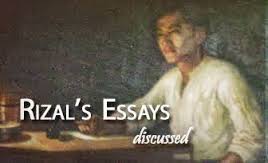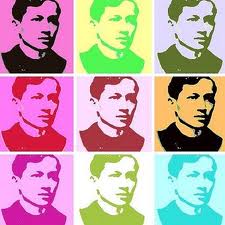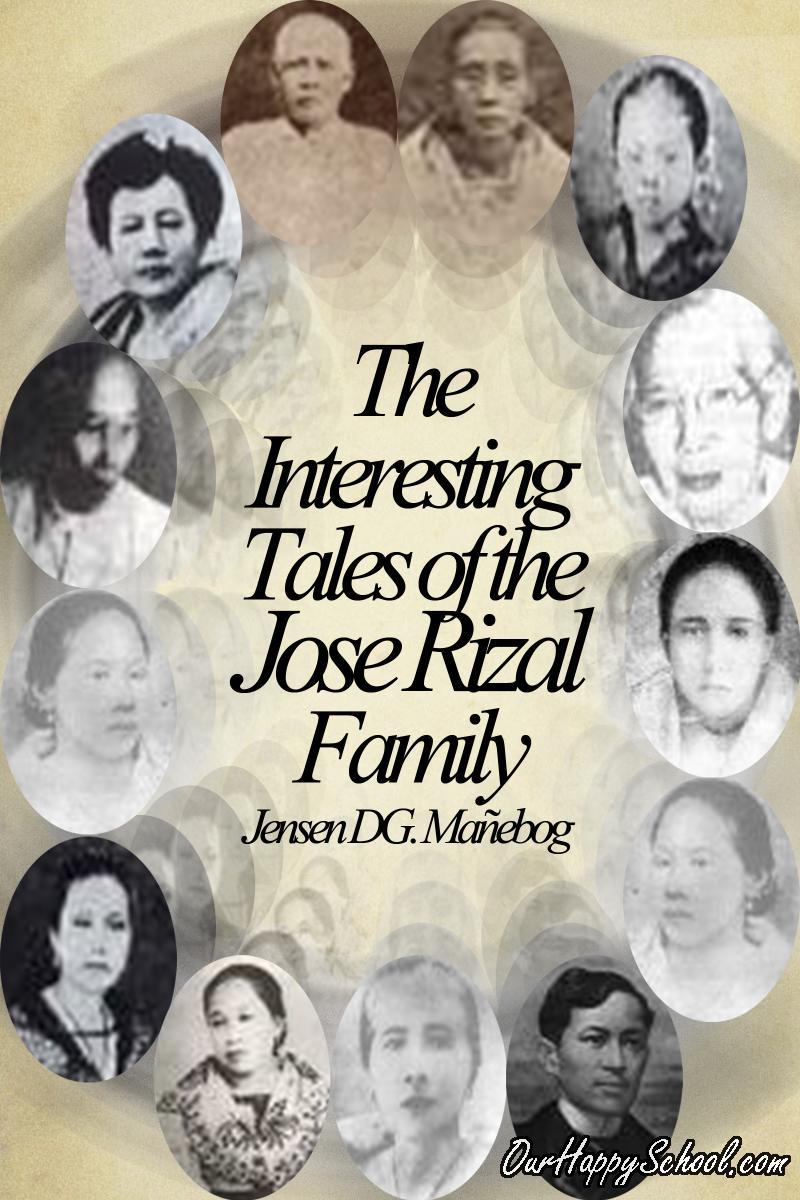Sponsored Links
Jose Rizal’s Essays and Articles
 THE NATIONAL HERO Dr. Jose Rizal composed several brilliant writings in his lifetime. These writings awakened the Filipino patriotism and paved the way for Philippine Revolution. Moreover, his writings were living proofs that “The pen is mightier than the sword.” The following are some of his timeless articles:
THE NATIONAL HERO Dr. Jose Rizal composed several brilliant writings in his lifetime. These writings awakened the Filipino patriotism and paved the way for Philippine Revolution. Moreover, his writings were living proofs that “The pen is mightier than the sword.” The following are some of his timeless articles:
Refer these to your siblings/children/younger friends:
HOMEPAGE of Free NAT Reviewers by OurHappySchool.com (Online e-Learning Automated Format)
Articles in Diariong Tagalog
“El Amor Patrio” (The Love of Country)
This was the first article Rizal wrote in the Spanish soil. Written in the summer of 1882, it was published in Diariong Tagalog in August. He used the pen name “Laong Laan” (ever prepared) as a byline for this article and he sent it to Marcelo H. Del Pilar for Tagalog translation.
Written during the Spanish colonization and reign over the Philippine islands, the article aimed to establish nationalism and patriotism among the natives. Rizal extended his call for the love of country to his fellow compatriots in Spain, for he believed that nationalism should be exercised anywhere a person is.
“Revista De Madrid” (Review of Madrid)
This article written by Rizal on November 29, 1882 wasunfortunatelyreturned to him because Diariong Tagalog had ceased publications for lack of funds.
Articles in La Solidaridad
“Los Agricultores Filipinos” (The Filipino Farmers)
This essay dated March 25, 1889 was the first article of Rizal published in La Solidaridad. In this writing, he depicted the deplorable conditions of the Filipino farmers in the Philippines, hence the backwardness of the country.
“A La Defensa” (To La Defensa)
This was in response to the anti-Filipino writing by Patricio de la Escosura published by La Defensa on March 30, 1889 issue. Written on April 30, 1889, Rizal’s article refuted the views of Escosura, calling the readers’ attention to the insidious influences of the friars to the country.
“Los Viajes” (Travels)
Published in the La Solidaridad on May 15, 1889, this article tackled the rewards gained by the people who are well-traveled to many places in the world.
“La Verdad Para Todos” (The Truth for All)
This was Rizal’s counter to the Spanish charges that the natives were ignorant and depraved. On May 31, 1889, it was published in the La Solidaridad.

"Vicente Barrantes’ Teatro Tagalo”
The first installment of Rizal’s “Vicente Barrantes” was published in the La Solidaridad on June 15, 1889. In this article, Rizal exposed Barrantes’ lack of knowledge on the Tagalog theatrical art.
“Defensa Del Noli”
The manuscripts of the “Defensa del Noli” was written on June 18, 1889. Rizal sent the article to Marcelo H. Del Pilar, wanting it to be published by the end of that month in the La Solidaridad.
“Verdades Nuevas”(New Facts/New Truths)
In this article dated July 31, 1889, Rizal replied to the letter of Vicente Belloc Sanchez which was published on July 4, 1889 in ‘La Patria’, a newspaper in Madrid. Rizal addressed Sanchez’s allegation that provision of reforms to the Philippines would devastate the diplomatic rule of the Catholic friars.
“Una Profanacion” (A Desecration/A Profanation)
Published on July 31, 1889, this article mockingly attacked the friars for refusing to give Christian burial to Mariano Herbosa, Rizal’s brother in law, who died of cholera in May 23, 1889. Being the husband of Lucia Rizal (Jose’s sister), Herbosa was denied of burial in the Catholic cemetery by the priests.
“Crueldad” (Cruelty),
Dated August 15, 1889, this was Rizal’s witty defense of Blumentritt from the libelous attacks of his enemies.
“Diferencias” (Differences)
Published on September 15, 1889, this article countered the biased article entitled “Old Truths” which was printed in La Patria on August 14, 1889. “Old Truths” ridiculed those Filipinos who asked for reforms.
“Inconsequencias” (Inconsequences)
The Spanish Pablo Mir Deas attacked Antonio Luna in the Barcelona newspaper “El Pueblo Soberano”. As Rizal’s defense of Luna, he wrote this article which was published on November 30, 1889.
“Llanto Y Risas” (Tears and Laughter)
Dated November 30, 1889, this article was a condemnation of the racial prejudice of the Spanish against the brown race. Rizal remembered that he earned first prize in a literary contest in 1880. He narrated nonetheless how the Spaniard and mestizo spectators stopped their applause upon noticing that the winner had a brown skin complexion.
“Filipinas Dentro De Cien Anos” (The Philippines within One Hundred Years)
This was serialized in La Solidaridad on September 30, October 31, December 15, 1889 and February 15, 1890. In the articles, Rizal estimated the future of the Philippines in the span of a hundred years and foretold the catastrophic end of Spanish rule in Asia. He ‘prophesied’ Filipinos’ revolution against Spain, winning their independence, but later the Americans would come as the new colonizer
The essay also talked about the glorious past of the Philippines, recounted the deterioration of the economy, and exposed the causes of natives’ sufferings under the cruel Spanish rule. In the essay, he cautioned the Spain as regards the imminent downfall of its domination. He awakened the minds and the hearts of the Filipinos concerning the oppression of the Spaniards and encouraged them to fight for their right.
Part of the essays reads, “History does not record in its annals any lasting domination by one people over another, of different races, of diverse usages and customs, of opposite and divergent ideas. One of the two had to yield and succumb.” The Philippines had regained its long-awaited democracy and liberty some years after Rizal’s death. This was the realization of what the hero envisioned in this essay.
Dated January 15, 1890, this article was the hero’s reply to Governor General Weyler who told the people in Calamba that they “should not allow themselves to be deceived by the vain promises of their ungrateful sons.” The statement was made as a reaction to Rizal’s project of relocating the oppressed and landless Calamba tenants to North Borneo.
“Sobre La Nueva Ortografia De La Lengua Tagala” (On The New Orthography of The Tagalog Language)
Rizal expressed here his advocacy of a new spelling in Tagalog. In this article dated April 15, 1890, he laid down the rules of the new Tagalog orthography and, with modesty and sincerity, gave the credit for the adoption of this new orthography to Dr. Trinidad H. Pardo de Tavera, author of the celebrated work “El Sanscrito en la Lengua Tagala” (Sanskrit in the Tagalog Language) published in Paris, 1884.
“I put this on record,” wrote Rizal, “so that when the history of this orthography is traced, which is already being adopted by the enlightened Tagalists, that what is Caesar’s be given to Caesar. This innovation is due solely to Dr. Pardo de Tavera’s studies on Tagalismo. I was one of its most zealous propagandists.”
“Sobre La Indolencia De Los Filipinas” (The Indolence of the Filipinos)
This logical essay is a proof of the national hero’s historical scholarship. The essay rationally countered the accusations by Spaniards that Filipinos were indolent (lazy) during the Spanish reign. It was published in La Solidaridad in five consecutive issues on July (15 and 31), August (1 and 31) and September 1, 1890.
Rizal argued that Filipinos are innately hardworking prior to the rule of the Spaniards. What brought the decrease in the productive activities of the natives was actually the Spanish colonization. Rizal explained the alleged Filipino indolence by pointing to these factors: 1) the Galleon Trade destroyed the previous links of the Philippines with other countries in Asia and the Middle East, thereby eradicating small local businesses and handicraft industries; 2) the Spanish forced labor compelled the Filipinos to work in shipyards, roads, and other public works, thus abandoning their agricultural farms and industries; 3) many Filipinos became landless and wanderers because Spain did not defend them against pirates and foreign invaders; 4) the system of education offered by the colonizers was impractical as it was mainly about repetitive prayers and had nothing to do with agricultural and industrial technology; 5) the Spaniards were a bad example as negligent officials would come in late and leave early in their offices and Spanish women were always followed by servants; 6) gambling like cockfights was established, promoted, and explicitly practiced by Spanish government officials and friars themselves especially during feast days; 7) the crooked system of religion discouraged the natives to work hard by teaching that it is easier for a poor man to enter heaven; and 8) the very high taxes were discouraging as big part of natives’ earnings would only go to the officials and friars.
Moreover, Rizal explained that Filipinos were just wise in their level of work under topical climate. He explained, “violent work is not a good thing in tropical countries as it is would be parallel to death, destruction, annihilation. Rizal concluded that natives’ supposed indolence was an end-product of the Spanish colonization.
Other Rizal’s articles which were also printed in La Solidaridad were “A La Patria” (November 15, 1889), “Sin Nobre” (Without Name) (February 28, 1890), and “Cosas de Filipinas” (Things about the Philippines) (April 30, 1890).
Historical Commentaries Written in London
“Ma-yi”
This historical commentary was written by Rizal in London on December 6, 1888.
“Acerca de Tawalisi de Ibn Batuta”
This historical commentaryis believed to form part of ‘Notes’ (written incollaboration with A.B. Meyer and F. Blumentritt) on a Chinese code in the Middle Ages, translated from the German by Dr. Hirth. Written on January 7, 1889, the article was about the “Tawalisi” which refers to the northern part of Luzon or to any of the adjoining islands.
It was also in London where Rizal penned the following historical commentaries: “La Political Colonial On Filipinas” (Colonial Policy In The Philippines), “Manila En El Mes De Diciembre” (December , 1872), “Historia De La Familia Rizal De Calamba” (History Of The Rizal Family Of Calamba), and“Los Pueblos Del Archipelago Indico (The People’s Of The Indian Archipelago)
Other Writings in London
“La Vision Del Fray Rodriguez” (The Vision of Fray Rodriguez)
Jose Rizal, upon receipt of the news concerning Fray Rodriguez’ bitter attack on his novel Noli Me Tangere, wrote this defense under his pseudonym “Dimas Alang.” Published in Barcelona, it is a satire depicting a spirited dialogue between the Catholic saint Augustine and Rodriguez. Augustine, in the fiction, told Rodriguez that he (Augustine) was commissioned by God to tell him (Rodriguez) of his stupidity and his penance on earth that he (Rodriguez) shall continue to write more stupidity so that all men may laugh at him. In this pamphlet, Rizal demonstrated his profound knowledge in religion and his biting satire.
“To The Young Women of Malolos”
Originally written in Tagalog, this famous essay directly addressed to the women of Malolos, Bulacan was written by Rizal as a response to Marcelo H. Del Pilar’s request.
Rizal was greatly impressed by the bravery of the 20 young women of Malolos who planned to establish a school where they could learn Spanish despite the opposition of Felipe Garcia, Spanish parish priest of Malolos. The letter expressed Rizal’s yearning that women be granted the same chances given to men in terms of education. In the olden days, young women were not educated because of the principle that they will soon be wives and their primary career would be to take care of the home and children. Rizal however advocated women’s right to education.
Below are some of the points mentioned by Rizal in his letter to the young women of Malolos: 1) The priests in the country that time did not embody the true spirit of Christianity; 2) Private judgment should be used; 3) Mothers should be an epitome of an ideal woman who teaches her children to love God, country, and fellowmen; 4) Mothers should rear children in the service of the state and set standards of behavior for men around her;5) Filipino women must be noble, decent, and dignified and they should be submissive, tender, and loving to their respective husband; and 6) Young women must edify themselves, live the real Christian way with good morals and manners, and should be intelligent in their choice of a lifetime partner.
Writings in Hong Kong
“Ang Mga Karapatan Ng Tao” (The Rights Of Man)
This was Rizal’s Tagalog translation of “The Rights of Man” which was proclaimed by the French Revolution in 1789.
“A La Nacion Espanola”(To The Spanish Nation)
Written in 1891, this was Rizal’s appeal to Spain to rectify the wrongs which the Spanish government and clergy had done to the Calamba tenants.
“Sa Mga Kababayan” (To My Countrymen)
This writing written in December 1891 explained the Calamba agrarian situation.
“Una Visita A La Victoria Gaol” (A Visit To Victoria Gaol), March 2, 1892
On March 2, 1892,Rizal wrote this account of his visit to the colonial prison of Hong Kong. He contrasted in the article the harsh Spanish prison system with the modern and more humane British prison system.
“Colonisation Du British North Borneo, Par De Familles De Iles Philippines” (Colonization Of British North Borneo By Families From The Philippine Islands)
This was Rizal’s elucidation of his pet North Borneo colonization project.
“Proyecto De Colonization Del British North Borneo Por Los Filipinos” (Project Of The Colonization Of British North Borneo By The Filipinos)
In this writing, Rizal further discussed the ideas he presented in “Colonization of British North Borneo by Families from the Philippine Islands.”
“La Mano Roja” (The Red Hand)
This was a writing printed in sheet form. Written in Hong Kong, the article denounced the frequent outbreaks of fires in Manila.
“Constitution of The La Liga Filipina”
This was deemed the most important writing Rizal had made during his Hong Kong stay. Though it was Jose Ma. Basa who conceived the establishment of Liga Filipina (Philippine League), his friend and namesake Jose Rizal was the one who wrote its constitution and founded it.
Articles for Trubner’s Record
Due to the request of Rizal’s friend Dr. Reinhold Rost, the editor of Trubner’s Record (a journal devoted to Asian Studies), Rizal submitted two articles:
Specimens of Tagal Folklore
Published in May 1889, the article contained Filipino proverbs and puzzles.
Two Eastern Fables(June 1889)
It was a comparative study of the Japanese and Philippine folklore. In this essay, Jose Rizal compared the Filipino fable, “The Tortoise and the Monkey” to the Japanese fable “Saru Kani Kassen” (Battle of the Monkey and the Crab).
Citing many similarities in form and content, Rizal surmised that these two fables may have had the same roots in Malay folklore. This scholarly work received serious attention from other ethnologists, and became a topic at an ethnological conference.
Among other things, Rizal noticed that both versions of the fable tackled about morality as both involve the eternal battle between the weak and the powerful. The Filipino version however had more philosophy and plainness of form whereas the Japanese counterpart had more civilization and diplomacy.
Other Writings
“Pensamientos De Un Filipino” (Reflections of A Filipino)
Jose Rizal wrote this in Madrid, Spain from 1883-1885. It spoke of a liberal minded and anti-friar Filipino who bears penalties such as an exile.
“Por Telefono”
This was a witty satire authored by “Dimas Alang” (one of the hero’s pen names) ridiculing the Catholic monk Font, one of the priests who masterminded the banning of the “Noli”. Published in booklet form in Barcelona, Spain, it narrated in a funny way the telephone conversation between Font and the provincial friar of the San Agustin Convent in Manila.
This pamphlet showed not only Rizal’s cleverness but also his futuristic vision. Amazingly, Rizal had envisaged that overseas telephonic conversations could be carried on—something which was not yet done during that time (Fall of 1889). It was only in 1901, twelve years after Rizal wrote the “Por Telefono,” when the first radio-telegraph signals were received by Marconi across the Atlantic.
“La Instruccion” (The Town Schools In The Philippines)
Using his penname “Laong Laan”, Rizal assessed in this essay the elementary educational system in the Philippines during his time. Having observed the educational systems in Europe, Rizal found the Spanish-administered education in his country poor and futile. The hero thus proposed reforms and suggeted a more significant and engaging system.
Rizal for instance pointed out that there was a problem in the mandated medium of instruction—the colonizers’ language (Spanish) which was not perfectly understood by the natives. Rizal thus favored Philippine languages for workbooks and instructions.
The visionary (if not prophetic) thinking of Rizal might have been working (again) when he wrote the essay. Interestingly, his call for educational reforms, especially his stand on the use of the local languages for instruction, is part of the battle cry and features of today’s K to 12 program in the Philippines ... continue reading (© 2013 by Jensen DG. Mañebog)
Jensen DG. Mañebog, the contributor, is a book author and professorial lecturer in the graduate school of a state university in Metro Manila. His unique textbooks and e-books on Rizal (available online) comprehensively tackle, among others, the respective life of Rizal’s parents, siblings, co-heroes, and girlfriends. (e-mail: jensenismo@gmail.com)
Tag: Jose Rizal’s Essays and Articles
For STUDENTS' ASSIGNMENT, use the COMMENT SECTION here: Bonifacio Sends Valenzuela to Rizal in Dapitan







